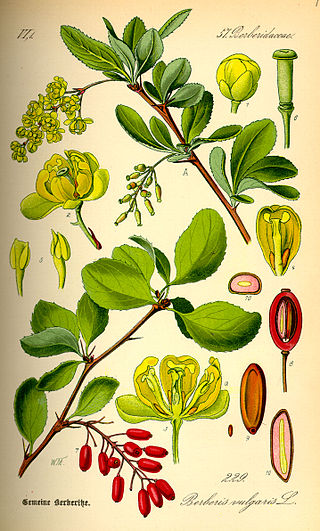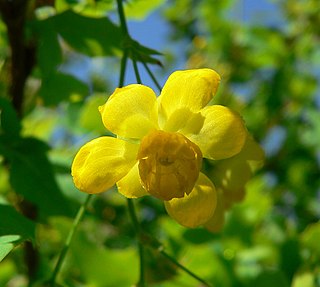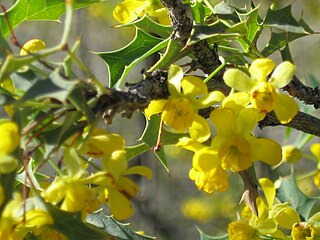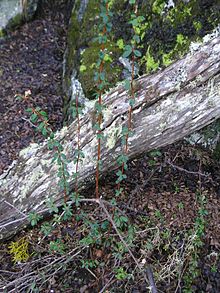
Berberis aquifolium, the Oregon grape or holly-leaved barberry, is a species of flowering plant in the family Berberidaceae, native to western North America. It is an evergreen shrub growing 1–3 meters tall and 1.5 m (5 ft) wide, with pinnate leaves consisting of spiny leaflets, and dense clusters of yellow flowers in early spring, followed by dark bluish-black berries.

Mahonia is a formerly accepted genus of approximately 70 species of shrubs or, rarely, small trees with evergreen leaves in the family Berberidaceae, native to eastern Asia, the Himalaya, North America, and Central America. They are closely related to the genus Berberis and as of 2023 the majority of botanical sources list it as a synonym for Berberis.

Berberis, commonly known as barberry, is a large genus of deciduous and evergreen shrubs from 1–5 m (3.3–16.4 ft) tall, found throughout temperate and subtropical regions of the world. Species diversity is greatest in South America and Asia; Europe, Africa and North America have native species as well. The best-known Berberis species is the European barberry, Berberis vulgaris, which is common in Europe, North Africa, the Middle East, and central Asia, and has been widely introduced in North America. Many of the species have spines on the shoots and all along the margins of the leaves.

The Berberidaceae are a family of 18 genera of flowering plants commonly called the barberry family. This family is in the order Ranunculales. The family contains about 700 known species, of which the majority are in the genus Berberis. The species include trees, shrubs and perennial herbaceous plants.

Berberis darwinii, Darwin’s barberry, is a species of flowering plant in the family Berberidaceae, native to southern Chile and Argentina and naturalized elsewhere. Regional vernacular names include michay, calafate, and quelung. Growing to 3–4 m (9.8–13.1 ft) tall, it is an evergreen thorny shrub.

Berberis vulgaris, also known as common barberry, European barberry or simply barberry, is a shrub in the genus Berberis native to the Old World. It produces edible but sharply acidic berries, which people in many countries eat as a tart and refreshing fruit.

Berberis nevinii, known by the common name Nevin's barberry, is a species of flowering shrub in the barberry family.

Berberis fremontii is a species of barberry known by the common name Frémont's mahonia.

Veronica elliptica, synonym Hebe elliptica, is a plant of the family Plantaginaceae. It is native to New Zealand, south Argentina, south Chile and the Falkland Islands. It is an evergreen, bushy shrub of 1 m or more in height, with green, oval leaves, 2–4 cm long. Flowers are white to pale mauve.

Berberis fortunei is a species of shrub in the family Berberidaceae, the barberry family, described in 1846. It is endemic to China, found in the provinces of Chongqing, Guangxi, Guizhou, Hubei, Hunan, Jiangxi, Sichuan, Taiwan, and Zhejiang. It is grown as an ornamental in many lands, with common names including Chinese mahonia, Fortune's mahonia, and holly grape.

Berberis valdiviana is a species of flowering plant in the barberry family Berberidaceae. It is an evergreen shrub endemic to Chile, where it is locally known as clen or espina en cruz. It is distributed between the Santiago Metropolitan and Los Ríos regions. The Latin specific name valdiviana refers to the Valdivia Province of Chile. It has simple, dark green, pointed leaves, glossy on the upper surfaces, up to 8.5 cm (3.3 in) long. The flowers, which appear in May, are grouped in hanging racemes. Individual flowers are orange, 5–8 mm (0.2–0.3 in) across, and are followed by purplish fruits. It is grown as an ornamental plant, but is not suitable for colder regions.

Berberis harrisoniana is a rare species of flowering plant in the barberry family, Berberidaceae. It is known by the common names Kofa barberry, Kofa Mountain barberry, Harrison's barberry, and red barberry.
Berberis swaseyi is a rare species of barberry endemic to the Edwards Plateau region of Texas. It grows in limestone ridges and canyons. The species is evergreen, with thick, rigid, 5-9-foliolate leaves. Berries are dry or juicy, white to red, about 9–16 mm in diam.

Berberis haematocarpa, Woot. with the common names red barberry, red Mexican barbery, Colorado barberry and Mexican barberry, is a species in the Barberry family in southwestern North America. It is also sometimes called algerita, but that name is more often applied to its relative, Mahonia trifoliolata.
Berberis wilcoxii is a shrub native to Arizona, New Mexico and Sonora. It is up to 2 m tall, with pinnately compound leaves of 5-7 leaflets, densely clustered racemes and ovoid berries up to 10 mm long. It is generally found in rocky canyons in mountainous areas at an elevation of 1700–2500 m.

Berberis bealei, also known as leatherleaf mahonia, Beale's barberry, is a species of evergreen shrub native to mainland China. The species has been regarded as the same species as Berberis japonica, native to Taiwan, but the two differ consistently in certain floral and leaf characters. Both species are widely cultivated in many countries as ornamentals. Berberis bealei has reportedly escaped cultivation and become established in the wild in scattered places in the south-eastern United States from Arkansas to Florida to Delaware.

Gunnera magellanica is a perennial rhizomatous dioeceous herb native to Chile, Argentina and the Falkland Islands, and Andean areas of Peru, Ecuador. In the southern part of its range it grows in damper parts of the Magellanic subpolar forests and Valdivian temperate forests, and shrub formations on Tierra del Fuego, with an altitudinal range from sea level to 1500m.

Ribes magellanicum is a South American species of shrubs in the currant family, found in Patagonia.

Berberis empetrifolia, sometimes called heath barberry, is a low, somewhat spiny shrub belonging to the barberries in the family Berberidaceae. The local names in Chile are zarcilla, monte negro and uva de la cordillera. It has small narrow entire leaves, and small yolk-colored flowers and later globose blue-black berries. The species is native to south of 30ºS in Argentina and Chile, where it grows on sunny, often gravelly soils, and is sometimes planted as an ornamental elsewhere in temperate climates.

Berberis ilicifolia, sometimes called holly barberry or holly-leaved barberry is a medium to high, spiny shrub belonging to the barberries in the family Berberidaceae. The local name in Chile is Chelia. It has ovate leaves with a few teeth that end in spines, reminiscent of holly leaves. Its orange flowers grow with three to seven together, which later produce globose blue-black berries. The species is native to south of 40ºS in Argentina and Chile, where it grows in Nothofagus woods. Flowers are present from August to December, while ripe berries are available between November and March.


















